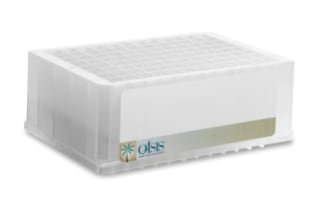
|
UNSPSC |
41115712 |
|
Brand |
Oasis |
|
Product Type |
Solid Phase Extraction |
|
Units per Package |
1 pk |
|
Chemistry |
HLB |
|
Endcapped |
No |
|
Format |
96-well Plate |
|
Mass Spec Compatibility |
Yes |
|
Mode |
Reversed Phase |
|
Particle Size |
30 µm |
|
Pore Size |
80 Å |
|
Sorbent Substrate |
Copolymer |
|
Sorbent Weight |
10 mg |
|
Water Wettable |
Yes |
|
pH Range Min |
0 pH |
|
pH Range Max |
14 pH |
|
Material |
Polypropylene |
|
Number of Wells |
96 |

Oasis HLB 96-well Plate, 10 mg Sorbent per Well, 30 µm, 1/pk
With simplifying and improving sample preparation at the top of mind, Waters’ creation of the Oasis HLB 96-well Plate is part of the Oasis family of solid-phase extraction products and lab equipment. The plate contains the Oasis HLB sorbent, a universal polymeric reversed-phase sorbent made for the extraction of acidic, basic, and neutral compounds from various matrices with a simple and generic protocol. By combining this sorbent’s unique purity with the proper device format and methodology, chromatographers can achieve robust, reproducible, and sensitive SPE methods.
Oasis HLB is a Hydrophilic-lipophilic-balanced, water-wettable, reversed-phase sorbent designed for a range of SPE needs. The sorbent is made using a specific range of two monomers, hydrophilic N-vinylpyrrolidone and lipophilic divnylbenzene, allowing for superior reversed-phase capacity with a neutral polar hook that enhances retention of polar analytes. This retention capacity exists across a wide polarity spectrum of analytes, even when the sorbent bed has run dry during conditioning or sample loading, allowing for more rugged and robust methods that prevent repetitive sample preparation.
The careful process design and strict quality controls used in the manufacturing of Oasis HLB plates have set new standards in batch to batch and lot to lot reproducibility across SPE sorbents. All sorbents and devices under the Oasis family are manufactured in Waters ISO 9000 registered facilities in compliance with cGMP guidelines for all Class 1 medical devices.
96-well extraction plates are designed to be used with a variety of manifold configurations and most robotic liquid handling systems. Offering high throughput and high recovery, the plates have an innovative two-stage well design that contribute to Oasis’ reputation for clean extracts, low matrix effects, and low method variability. They also work well in conjunction with other Waters’ products, such as the XBridge BEH C18 XP Column, 130Å, 2.5 µm, 2.1 mm X 50 mm, 1/pk.
Why Is Sample Preparation/SPE Important?
Sample preparation is a key component of any analytical method and may account for up to 80% of operating costs and work activity in laboratories. SPE offers solutions to a range of major challenges that occur in sample preparation activities. The use of SPE is proven to be effective at removing interference and allows for sensitive, selective, and robust analysis. It also successfully removes phospholipids and lysophospholipids, which contribute to ion suppression and can create undesired method variability. SPE also enables the enrichment of selected analytes without concentrating the interferences. Advances in SPE technology and robotic automation make SPE cost-effective, time-efficient, and reliable in a variety of analytical techniques.